绩效管理赫尔曼·阿吉斯.docx
- 格式:docx
- 大小:25.38 KB
- 文档页数:6
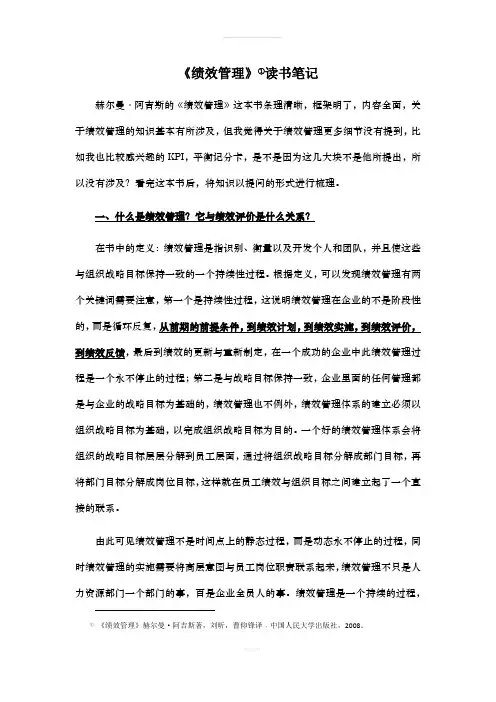
《绩效管理》①读书笔记赫尔曼·阿吉斯的《绩效管理》这本书条理清晰,框架明了,内容全面,关于绩效管理的知识基本有所涉及,但我觉得关于绩效管理更多细节没有提到,比如我也比较感兴趣的KPI,平衡记分卡,是不是因为这几大块不是他所提出,所以没有涉及?看完这本书后,将知识以提问的形式进行梳理。
一、什么是绩效管理?它与绩效评价是什么关系?在书中的定义:绩效管理是指识别、衡量以及开发个人和团队,并且使这些与组织战略目标保持一致的一个持续性过程。
根据定义,可以发现绩效管理有两个关键词需要注意,第一个是持续性过程,这说明绩效管理在企业的不是阶段性的,而是循环反复,从前期的前提条件,到绩效计划,到绩效实施,到绩效评价,到绩效反馈,最后到绩效的更新与重新制定,在一个成功的企业中此绩效管理过程是一个永不停止的过程;第二是与战略目标保持一致,企业里面的任何管理都是与企业的战略目标为基础的,绩效管理也不例外,绩效管理体系的建立必须以组织战略目标为基础,以完成组织战略目标为目的。
一个好的绩效管理体系会将组织的战略目标层层分解到员工层面,通过将组织战略目标分解成部门目标,再将部门目标分解成岗位目标,这样就在员工绩效与组织目标之间建立起了一个直接的联系。
由此可见绩效管理不是时间点上的静态过程,而是动态永不停止的过程,同时绩效管理的实施需要将高层意图与员工岗位职责联系起来,绩效管理不只是人力资源部门一个部门的事,百是企业全员人的事。
绩效管理是一个持续的过程,①《绩效管理》赫尔曼·阿吉斯著,刘昕,曹仰锋译﹒中国人民大学出版社,2008。
是持续提升个人、部门和组织绩效,完成战略目标,与绩效评价是不一样的,绩效评价是绩效管理中的一个环节,是绩效管理的一种手段,它的目的是绩效考评的成绩或者结果。
如果一个企业一年对员工绩效只进行一次评价,而不进行后续的反馈和辅导来帮助员工改进绩效,则这个组织中没有绩效管理体系,只有绩效评价体系,一个完整的绩效管理体系,不仅仅是绩效评价,也包括后续的绩效反馈与绩效更新和重新制定,帮助员工取得个人发展,从而实现组织战略目标。

课题:第一章概论第一节绩效课时:2 周次:授课日期:授课地点:授课方式及手段:讲授、讨论教学目标:了解绩效的内涵及其主要影响因素教学重难点:关于个人绩效的不同观点划分、及不同层次、不同领域、不同阶段下的绩效内容影响绩效的四大因素之间的关系教学过程与内容:新课导入——导引案例:英国电信环球服务公司的绩效管理体系1.英国电信环球服务公司的绩效管理体系都包括哪些内容?2.英国电信环球服务公司采取了哪些行动推广绩效管理体系?第一节绩效一、绩效的内涵1.绩效一词来源于英文单词performance,其一般意义是指工作的效果和效率。
2.对绩效概念的探索起源于对员工绩效的界定上。
3.准确理解个人绩效的内涵还需要了解工作态度、工作能力与工作结果的关系。
图1-1 工作态度、工作能力与工作结果的关系4.本书认为绩效是指组织及个人的履职表现和工作任务完成的情况,是组织期望的为实现其目标而展现在组织不同层面上的工作行为及其结果,它是组织的使命、核心价值观、愿景及战略的重要表现形式。
(1)绩效必须与组织战略的要求保持一致(2)第二,绩效是有层次的图1-2绩效的三个层次:组织绩效、群体绩效和个人绩效(3)绩效的最终表现形式是工作行为与结果案例1-1职场新人的绩效变化小王是名牌大学毕业生,毕业后进入某单位工作。
由于种种原因,该单位很久没有招聘新人,小王的同事们基本比小王要年长很多。
刚刚参加工作的小王认为自己要好好打拼,努力工作,经营好自己的事业。
于是,小王虚心向前辈学习,积极主动参与各项工作,经常自发加班,一个人能完成几个人的工作量。
领导看了非常满意。
渐渐地,小王发现单位在为员工升职加薪时首先考虑的是资历,其次才是工作业绩,加上同事们劝小王“注意身体,不要太拼”,因此小王的绩效呈现出下滑趋势。
领导对此表示不解,打算找小王了解情况。
想一想:是什么影响了小王的工作绩效?在现实生活中,影响绩效的因素有哪些?请结合具体事例进行说明。
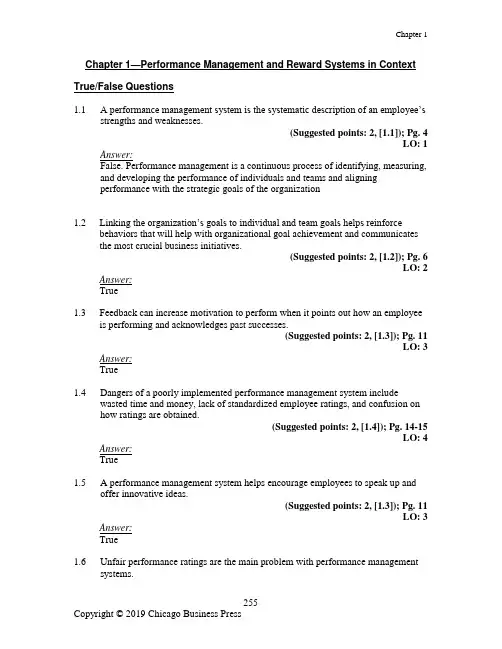
Chapter 1—Performance Management and Reward Systems in Context True/False Questions1.1 A performance management system is the systematic description of an employee’sstrengths and weaknesses.(Suggested points: 2, [1.1]); Pg. 4LO: 1 Answer:False. Performance management is a continuous process of identifying, measuring, and developing the performance of individuals and teams and aligningperformance with the strategic goals of the organization1.2Linking the organization’s goals to individual and team goals helps reinforcebehaviors that will help with organizational goal achievement and communicates the most crucial business initiatives.(Suggested points: 2, [1.2]); Pg. 6LO: 2 Answer:True1.3Feedback can increase motivation to perform when it points out how an employeeis performing and acknowledges past successes.(Suggested points: 2, [1.3]); Pg. 11LO: 3 Answer:True1.4Dangers of a poorly implemented performance management system includewasted time and money, lack of standardized employee ratings, and confusion on how ratings are obtained.(Suggested points: 2, [1.4]); Pg. 14-15LO: 4 Answer:True1.5 A performance management system helps encourage employees to speak up andoffer innovative ideas.(Suggested points: 2, [1.3]); Pg. 11LO: 3 Answer:True1.6Unfair performance ratings are the main problem with performance managementsystems.(Suggested points: 2, [1.4]); Pg. 16LO: 5 Answer:False. Performance ratings are the “canary in the coal mine” and indicators ofproblems with the PM system1.7Reliability and validity of performance management systems refer to the samething.(Suggested points: 2, [1.5]); Pg. 20LO: 6 Answer:False. Reliability refers to consistency and freedom from error, while Validityrefers to the fact that the measures include all relevant performance facets and do not include irrelevant information.1.8The strategic purpose of PM systems involves constructing the strategic vision forthe organization.(Suggested points: 2, [1.5]); Pg. 6LO: 2 Answer:False. The strategic purpose of PM systems is to link an organization’s goals with individuals’ goals.1.9 A reliable performance management system includes all relevant performancefacets and does not include irrelevant performance facets.(Suggested points: 2, [1.5]); Pg. 20LO: 6 Answer:False. This describes a system’s validity, not reliability. A reliable performancemanagement system is consistent. For example, if two supervisors provided ratings of the same employee, or if one supervisor rated the same employee twice over ashort period of time during which nothing noticeable occurs, then the ratingsshould be similar or identical.1.10Distributive justice is the perception that the performance evaluation received isfair relative to the work performed.(Suggested points: 2, [1.5]); Pg. 20LO: 6 Answer:True1.11Performance management systems in foreign subsidiaries often differ from thosein home country headquarters as differences in the power distance (i.e., the degree to which a society accepts unequal distribution of power) increase between/among countries.(Suggested points: 2, [1.5]); Pg. 19LO: 6 Answer:True1.12The current consensus amongst most employees (as reported by the CEB) is thatperformance review systems are helpful in improving their productivity.(Suggested points: 2, [1.1]); Pg. 6LO: 1 Answer:False. 66% of employees feel that the performance review process interferes with their productivity.1.13Poorly implemented performance management systems have little to no negativelegal ramifications for the organization.(Suggested points: 2, [1.4]); Pg. 15LO: 4 Answer:False. Poorly implemented performance management systems are likely to result in negative legal ramifications such as possible discrimination lawsuits.1.14Many large companies such as General Electric, Deloitte, and Adobe no longer useperformance ratings at all.(Suggested points: 2, [1.4]); Pg. 16-17LO: 1 Answer:False. Many large companies who tried to eliminate performance ratings are now using ratings again—but they are using more than one system and emphasizingdevelopmental feedback.Multiple-Choice Questions1.15________________ is a continuous process of identifying, measuring, anddeveloping the performance of individuals and teams and aligning performancewith the strategic goals of the organization.A.Strategic planningB.Performance managementC.Reward systemD.Performance appraisal(Suggested points: 2, [1.1]); Pg. 4LO: 1 Answer: B1.16Dangers of a poorly implemented performance management system include all ofthe following EXCEPT:A.Increased emphasis on behaviors rather than resultswsuits/internal complaints of discriminationC.Biased performance ratingsD.Decreased employee motivation(Suggested points: 2, [1.4]); Pg. 14-15LO: 4 Answer: A1.17When employees of an organization do not see the PM system as fair, theorganization may witness from its employees all of the following EXCEPT:A.Job burnoutB.Lowered self-esteemC.Increased engagementwsuits(Suggested points: 2, [1.4]); Pg. 16LO: 4 Answer: C1.18The meaningfulness characteristic of performance management systems includesall the following EXCEPT:A.Standards and evaluations are important and relevantB.All functions that an employee performs are evaluatedC.System should evaluate performance regularlyD.Evaluator skill should be developed continuouslyE.Results should be used for administrative purposes(Suggested points: 2, [1.5]); Pg. 19LO: 6 Answer: B1.19The ___________ purpose of PM systems is to furnish valid and usefulinformation for making employment decisions including salary adjustments,promotions, and terminations.A.strategicrmationalC.administrativeD.developmental(Suggested points: 2, [1.2]); Pg. 6LO: 2 Answer: C1.20Information gained from the organizational maintenance purpose of a PM systemis used for all of the following EXCEPT:A.Workforce planningB.Evaluating the effectiveness of job descriptionsC.Evaluating the effectiveness of HR programsD.Creating talent inventories(Suggested points: 2, [1.2]); Pg. 8LO: 2Answer: C1.21 Performance management systems should be thorough, meaning that:A.All employees should be evaluatedB.An employee’s flaws should be discussed at lengthC.The review should cover the entire review periodD.A and C(Suggested points: 2, [1.5]); Pg. 19LO: 6 Answer: D1.22An ideal PM system is __________, which means that performance is evaluatedand feedback is given on an ongoing basis, the appraisal meeting consists of two-way communication, and performance standards are clear.A.openB.standardizedC.ethicalD.specific(Suggested points: 2, [1.5]); Pg. 21LO: 6 Answer: A1.23PM system information is important for the effective implementation of which ofthe following HR function(s)?A.Workforce planningB.TrainingC.Recruitment and selectionD.All of the above(Suggested points: 2, [1.6]); Pg. 23LO: 7 Answer: D1.24All of the following are possible benefits of a performance management systemEXCEPT:A.Protection from lawsuitsB.Employees become more ethicalC.Employees become more competentD.The definitions of job and criteria are clarified(Suggested points: 2, [1.3]); Pg. 10-13LO: 3 Answer: B1.25Which of the following does the text identify as a possible danger of a poorlyimplemented performance management system?A.Salaries must be increased.B.Poorly performing employees will always stay at the organization.C.No time or money is spent on the system.D.Motivation to perform is decreased.(Suggested points: 2, [1.4]); Pg. 14-15LO: 4 Answer: D1.26The ____________ characteristic allows employees to receive concrete guidanceabout what is expected of them and how they can meet those expectations:A.StandardizationB.SpecificityC.Strategic congruenceD.Correctability(Suggested points: 2, [1.5]); Pg. 20LO: 6 Answer: B1.27All of the following are characteristics of an ideal performance managementsystem EXCEPT:A.ReliabilityB.MeaningfulnessC.InexpensiveD.Thorough(Suggested points: 2, [1.5]); Pg. 18-22LO: 6 Answer: C1.28All of the following are purposes of a performance management system EXCEPT:A.Make decisions about retention and terminationB.Provide documentationC.Increase profitsD.Give the HR department something to do(Suggested points: 2, [1.2]); Pg. 6-10LO: 2 Answer: D1.29An ideal performance management system is correctable. What does this mean?A.If an employee is dissatisfied with a rating, it will be changed.B.If an employee is dissatisfied with a rating, there is a process to appeal therating decision.C.An ideal performance management system is not correctable.D.None of the above is correct.(Suggested points: 2, [1.5]); Pg. 21LO: 6 Answer: B1.30In which country should performance management be adapted to the country’sunique culture?A.South KoreaB.South AfricaC.AustraliaD.All of the above(Suggested points: 2, [1.5]); Pg. 18-19LO: 6 Answer: D1.31In what manner is performance management typically similar around the world?A.Standardization of performance measurementB.Emphasis on behavior versus results of employee performanceC.Interpersonal aspectsD.None of the above(Suggested points: 2, [1.5]); Pg. 19-20LO: 6 Answer: A1.32All of the following are related to the changing nature of performancemanagement EXCEPT:A.Cloud computingB.Big DataC.Technological advancements and virtual teamsD.Changing workforce demographicsE.Rising costs(Suggested points: 2, [1.7]); Pg. 24-26LO: 8 Answer: E1.33The performance management system should link to other human resources anddevelopment activities EXCEPT:A.TrainingB.Workforce planningC.Recruitment and hiringD.Financial accounting(Suggested points: 2, [1.6]); Pg. 23-24LO: 7 Answer: D1.34Current factors that are bringing about changes to the performance managementprocess include all of the following EXCEPT:A.Big DataB.Demographic changes in the workforceC.Equal pay legislationD.Electronic performance monitoring(Suggested points: 2, [1.7]); Pg. 24-26LO: 8 Answer: CShort-Answer and Essay-Type Questions1.35You want to transition your organization’s performance appraisal system into aperformance management system. Write a one-page memo to your supervisordescribing the advantages of having a well-designed, properly implementedperformance management system.(Suggested points: 2, [1.3]); Pg. 10-14LO: 3 Answer:Memos will vary, but they should all include the following benefits of a well-designed and implemented PM system:Performance appraisal is the systematic description of an employee’s strengths and weaknesses, whereas performance management is a continuous process ofidentifying, measuring, and developing the performance of individuals and teams and aligning performance with the strategic goals of the organization.o Increased motivation to perform. If given correctly, feedback can increase the motivation to improve future performance.o Increased self-esteem. Receiving feedback about one’s performance fulfills a basic need to be appreciated and valued at work. Feeling appreciated and valuedwill increase an employee’s self-esteem.o Managers gain insight about subordinates. Direct supervisors and other managers in charge of the appraisal gain new insights into the person beingappraised.o Clarification and definition of job and criteria. The job of the person being appraised may be clarified and better defined; thus, employees gain a betterunderstanding of what it takes to be a successful performer.o Self-insight and development. Participants in the system also gain a better understanding of their strengths and weaknesses, which can help them betterdefine future career paths.o Fair and appropriate administrative actions. Performance management systems provide valid information about performance that can be used for administrativeactions such as merit increases, promotions, transfers, and terminations.o Organizational goals made clear. The goals of the unit and organization are made clear.o More competent employees. Performance of employees is improved, especially when developmental plans are put in place.o Protections from lawsuits. Data collected through performance management systems can help document compliance with regulations.o Differentiates between good and poor performers. Performance management systems allow for a quicker identification of good and poor performers.o Communicates supervisor’s view of performance. Good systems force managers to communicate to their subordinates their judgments and expectationsregarding performance.1.36Identify the two main components of the definition of Performance Managementand write one sentence describing each(Suggested points: 2, [1.1]); Pg. 4LO: 1 Answer:Two main components are:o Continuous process: Performance management is ongoing. It involves an ongoing process of setting goals and objectives, observing performance,talking about performance, and giving and receiving ongoing coaching andfeedbacko Alignment with strategic goals. Performance management requires that managers ensure that employees’ activities and outputs are congruent with theo rganization’s goals, and consequently, help the organization gain acompetitive advantage. Performance management therefore creates a directlink between employee and team performance and organizational goals, andmakes the employees’ contribution to the o rganization explicit1.37There are several characteristics of an ideal performance management system.Please discuss five characteristics of an ideal system and explain how anorganization can achieve each characteristic. (For example, one characteristic of an ideal PM system is that it is reliable. An organization can make its system reliable by ensuring that performance measures are consistent across equally or similarlyqualified judges and free of error.)(Suggested points: 5, [1.5]); Pg. 18-22LO: 6 Answer:The answer may involve any five of these characteristics:o Congruent with strategy. The system should be congruent with the unit’s and organization’s strategy. Organizations need to ensure that individual goals arealigned with unit and organizational goals.o Congruent with context. The system should be congruent with theorganization’s culture as well as the broader cultural context of the region orcountry.o Thorough. All employees should be evaluated, all major job responsibilities should be evaluated, the evaluation should include performance spanning theentire review period, and feedback should be given on positive performanceaspects as well as those that are in need of improvement. Organizations shouldtrain managers on how to give thorough reviews.o Practical. Good systems are available, easy to use, and acceptable to those who want to use them to make decisions, and the benefits of using the systemoutweigh the costs. Organizations need to get employee and manager inputwhen designing the PM system to ensure that both parties are able to use the system and trust its results.o Meaningful. The standards and evaluations conducted for each job function must be considered important and relevant, the system must emphasize those functions that are under the control of the employee only, evaluations must take place at regular intervals and at appropriate moments, the system should provide for continuing skill development of evaluators, and the results should be used for important administrative decisions. Again, organizations must involveemployees and managers in the development of the system and train them on how to use the system effectively in order for it to be meaningful.o Specific. A good system provides detailed and concrete guidance to employees about what is expected of them and how they can meet these expectations.Supervisors must clearly communicate to employees what is expected of them. o Identifies effective and ineffective performance. The system discriminates between effective and ineffective performance. Organizations designperformance criteria in a way that distinguishes between good and badperformance.o Reliable. The system uses performance measures that are consistent, free of error, and high in inter-rater reliability.o Valid. The measures of performance are relevant (i.e., include important performance facets), they are not deficient (i.e., do not include unimportantperformance facets), and they are not contaminated (because they measure only what the employee can control). Organizations identify through job analysis what are essential for the job and only measure those results and behaviors.o Acceptable and Fair. A good system is acceptable and perceived as fair by all participants. Organizations can set clear rules that are applied consistently by all supervisors.o Inclusive. Good systems include input from multiple sources on an ongoing basis. Organizations should encourage employees to conduct self-appraisals, and employees must participate in the process of creating the system byproviding input regarding what should be measured and how it should bemeasured.o Open. Performance is evaluated frequently, performance feedback is provided on an ongoing basis, the appraisal meeting consists of a two-waycommunication, and standards are clear and communicated continually.Organizations should train managers on how to effectively give feedback and communicate expectations to their employees.o Correctable. When employees perceive an error has been made, there should bea mechanism through which this can be corrected. Organizations shouldestablish an appeals process, through which employees can challenge what may be unjust decisions. This is an important aspect of a good performancemanagement system.o Standardized. As noted previously, good systems are standardized. This means that performance is evaluated consistently across people and time.Organizations must train individuals in charge of appraisals.Chapter 1 o Ethical. Good systems comply with ethical standards. Organizations should train managers to suppress personal self-interest when providing evaluations, toonly evaluate performance dimensions for which they have sufficientinformation, and to respect the employee.1.38According to the text, performance management is …(Suggested points: 2, [1.1]); Pg. 4LO: 1 Answer:A continuous process of identifying, measuring, and developing the performanceof individuals and teams and aligning performance with the strategic goals of theorganization.1.39Performance management systems serve many purposes. Describe thedevelopmental purpose.(Suggested points: 2, [1.2]); Pg. 7-8LO: 2 Answer:A performance management system serves a developmental purpose by usingperformance feedback to allow individuals to learn about their strengths andweaknesses, by identifying training needs, and by helping management andemployees to make better decisions regarding job assignments.1.40Describe the strategic purpose of performance management.(Suggested points: 2, [1.2]); Pg. 6LO: 2 Answer:A performance management system serves a strategic purpose by linking theorganization’s goals with individual employee goals; in this way, the performance management system reinforces behaviors consistent with organizational goals.1.41What is meant when we say that an ideal performance management system mustbe practical?(Suggested points: 2, [1.5]); Pg. 19LO: 6 Answer:When we say that an ideal performance management system is practical, we mean that it is available, easy to use, and acceptable to those who want to use it fordecisions, and the benefits of using the system outweigh the costs.1.42What is meant when we say that an ideal performance management system mustbe valid?(Suggested points: 2, [1.5]); Pg. 20LO: 6 Answer:Part I: Strategic and General Considerations___________________________________________________ When we say that an ideal performance management system is valid, we mean that the measures of performance are relevant (i.e., include important performancefacets), they are not deficient (i.e., do not include unimportant performance facets), and they are not contaminated (because they measure only what the employee can control).1.43What is meant when we say that an ideal performance management system mustbe reliable?(Suggested points: 2, [1.5]); Pg. 20LO: 6 Answer:When we say that an ideal performance management system is reliable, we mean that the system uses performance measures that are consistent across judges ofequal or similar qualification and free of error.1.44List four possible dangers of a poorly implemented performance managementsystem.(Suggested points: 2, [1.4]); Pg. 14-15LO: 4 Answer:Possible dangers of a poorly-implemented performance management systeminclude the following:o Lowered self-esteemo Increased turnoveo Damaged relationshipso Decreased motivation to performo Employee burnout and job dissatisfactiono Use of misleading informationo Wasted time and moneyo Emerging biaseso Unclear ratings systemo Varying and unfair standards and ratingso Unjustified demands on managers’ and employees’ resourceso Increased risk of litigation1.45List four possible contributions of a good performance management system.(Suggested points: 2, [1.3]); Pg. 10-13LO: 3 Answer:Possible contributions of a good performance management system include thefollowing:o Self-insight and development are enhanced.o Self-esteem of employees is increased.o Motivation to perform is increased.o Employee engagement is enhanced.o Employees become more competent.Chapter 1 o Voice behavior is encouraged.o Definition of job and criteria are clarified.o Employee misconduct is minimized.o Declines in performance can be addressed early on.o Motivation, commitment, and intentions to stay in the organization are enhanced.o Managers gain insight about direct reports.o There is better and more timely differentiation between good and poor performers.o Supervisor’s views of performance are communicated more clearly.o Administrative actions are more fair and appropriate.o Organizational goals are made clear.o There is better protection from lawsuits.o Organizational change is facilitated.1.46Identify two ways in which PM systems in the United States might differ fromthose in South Korea?(Suggested points: 2, [1.5]); Pg. 18LO: 6 Answer:Possible differences between the United States and South Korea might include:o Espouses collectivist values over individual performanceo Male-dominatedo Respect for hierarch in terms of political and administrative leaderso Sociocultural norms have a clear influence on organizational decision making and practices。
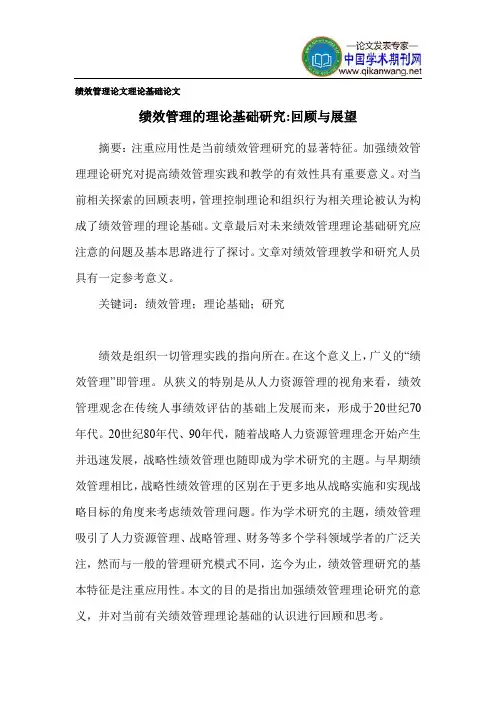
绩效管理论文理论基础论文绩效管理的理论基础研究:回顾与展望摘要:注重应用性是当前绩效管理研究的显著特征。
加强绩效管理理论研究对提高绩效管理实践和教学的有效性具有重要意义。
对当前相关探索的回顾表明,管理控制理论和组织行为相关理论被认为构成了绩效管理的理论基础。
文章最后对未来绩效管理理论基础研究应注意的问题及基本思路进行了探讨。
文章对绩效管理教学和研究人员具有一定参考意义。
关键词:绩效管理;理论基础;研究绩效是组织一切管理实践的指向所在。
在这个意义上,广义的“绩效管理”即管理。
从狭义的特别是从人力资源管理的视角来看,绩效管理观念在传统人事绩效评估的基础上发展而来,形成于20世纪70年代。
20世纪80年代、90年代,随着战略人力资源管理理念开始产生并迅速发展,战略性绩效管理也随即成为学术研究的主题。
与早期绩效管理相比,战略性绩效管理的区别在于更多地从战略实施和实现战略目标的角度来考虑绩效管理问题。
作为学术研究的主题,绩效管理吸引了人力资源管理、战略管理、财务等多个学科领域学者的广泛关注,然而与一般的管理研究模式不同,迄今为止,绩效管理研究的基本特征是注重应用性。
本文的目的是指出加强绩效管理理论研究的意义,并对当前有关绩效管理理论基础的认识进行回顾和思考。
一、绩效管理研究的基本特征管理理论和实践之间具有密切联系。
如麦格雷戈(1960)所言,“任何管理都是建立在设想、假设与归纳的基础之上的,也就是说,是以一定的理论为基础的”。
“我们有可能做出不够充分的理论假设,但绝不可能在没有假设的前提下,制定出管理决策及措施”。
然而就绩效管理而言,当前绩效管理文献的基本特征是从管理者的视角出发、以“应当怎样”的知识形式出现,而对绩效管理观念、原则所依赖的理论和实证基础的研究则非常少见。
从绩效管理研究的情况来看,研究者指出“大量的研究往往都涉及某一特定的绩效管理工具或技术的运用,以案例来进行相关研究的现象也非常普遍”。
更深入的分析表明,绩效管理研究的模式与一般的管理研究模式存在系统性的差异。

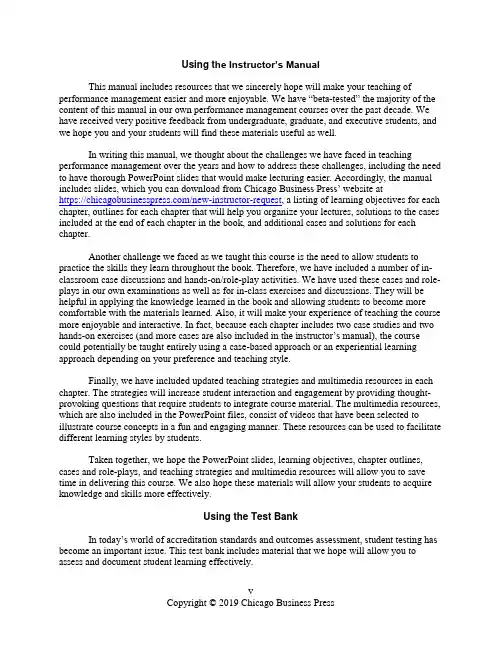
Using t he Instructor’s ManualThis manual includes resources that we sincerely hope will make your teaching of performance management easier and more enjoyable. We have “beta-tested” the majority of the content of this manual in our own performance management courses over the past decade. We have received very positive feedback from undergraduate, graduate, and executive students, and we hope you and your students will find these materials useful as well.In writing this manual, we thought about the challenges we have faced in teaching performance management over the years and how to address these challenges, including the need to have thorough PowerPoint slides that would make lecturing easier. Accordingly, the manual includes slides, which you can download from Chicago Business Press’ website athttps:///new-instructor-request, a listing of learning objectives for each chapter, outlines for each chapter that will help you organize your lectures, solutions to the cases included at the end of each chapter in the book, and additional cases and solutions for each chapter.Another challenge we faced as we taught this course is the need to allow students to practice the skills they learn throughout the book. Therefore, we have included a number of in- classroom case discussions and hands-on/role-play activities. We have used these cases and role-plays in our own examinations as well as for in-class exercises and discussions. They will be helpful in applying the knowledge learned in the book and allowing students to become more comfortable with the materials learned. Also, it will make your experience of teaching the course more enjoyable and interactive. In fact, because each chapter includes two case studies and two hands-on exercises (and more cases ar e also included in the instructor’s manual), the course could potentially be taught entirely using a case-based approach or an experiential learning approach depending on your preference and teaching style.Finally, we have included updated teaching strategies and multimedia resources in each chapter. The strategies will increase student interaction and engagement by providing thought-provoking questions that require students to integrate course material. The multimedia resources, which are also included in the PowerPoint files, consist of videos that have been selected to illustrate course concepts in a fun and engaging manner. These resources can be used to facilitate different learning styles by students.Taken together, we hope the PowerPoint slides, learning objectives, chapter outlines, cases and role-plays, and teaching strategies and multimedia resources will allow you to save time in delivering this course. We also hope these materials will allow your students to acquire knowledge and skills more effectively.Using the Test BankIn today’s world of accreditation standards and outcomes assessment, student testing has become an important issue. This test bank includes material that we hope will allow you to assess and document student learning effectively.The test bank includes three types of questions: (1) true/false, (2) multiple-choice, and (3) essay-type. The Instructor’s Manual includes the learning objectives for each chapter. The scoring suggested in this Test Bank uses these learning objectives and weighs them according to whether the student is required to demonstrate knowledge, understanding, and/or application of the concepts learned. Knowledge includes the use of correct terminology as well as the ability to list and describe concepts. Understanding goes beyond knowledge in that students are asked to explain the concept. Application requires students to describe how implementation of the concept would take place; this might include anticipation and resolution of problems in the given environment. The majority of application questions are included as part of the cases, which are part of the Instructor’s Manual and can be used for examinations as well as in-class discussions.The suggested scoring, in the event you wish to use the cases as part of your examinations, was created as follows. Each learning objective is assigned 2, 3, or 5 points depending on the complexity of the learning objective:Knowledge = 2Understanding = 3Application = 5Knowledge includes the use of correct terminology as well as the ability to list and describe concepts. Understanding goes beyond knowledge in that students are asked to explain the concept. Application requires students to describe how implementation of the concept would take place; this might include anticipation and resolution of problems in the given environment.A given answer might refer to a single, relatively simple learning objective and require the use of proper terminology (knowledge). Alternatively, an answer may require that the students explain a concept (understanding) or describe how to implement it (application). If a particular objective includes a knowledge, an understanding, and an application component, the scoring would be 1 X (2 + 3 + 5) = 10 points. If more than one learning objective is met in an answer, it would be possible to get more points. For example, if a question addresses three learning objectives requiring knowledge and understanding, then the resulting score would be 3 X (2 + 3) = 15 points.Each question has a code next to it noting (1) the recommended score assigned to the question, (2) the section of the chapter from which content is drawn, (3) the page numbers where the answers can be found, and (4) the specific learning objective(s) assessed with the question. For example, the code (Suggested points: 2, [9.1]); Pg. 260 LO: 1 means that the recommended number of points is 2 (i.e., the question is assessing mainly knowledge), the answer is found in section 1 of Chapter 9 on page 260, and that the question refers to learning objective 1. Suchlow-scoring questions are primarily true/false and multiple-choice questions. Similarly, the code (Suggested points: 10, .2[7.1], .2[7.2], .2[7.3], .2[7.4], .2[7.5]) LO: 2, 3, 4, 6, 7, 8 indicates a recommended score of 10 points, the question refers to sections 1, 2, 3, 4, and 5 in Chapter 7, and to learning objectives 2, 3, 4, 6, 7, and 8. The weights before the section numbers indicate that the question assesses content from each of the sections equally (i.e., a weight of .2 each). Such high-scoring questions are primarily essay-type questions.New to this Fourth EditionThis manual’s fourth edition includes many revisions and additions to the third edition. Overall, this fourth edition includes revisions to improve readability throughout all 11 chapters. More substantively, the fourth edition is vastly expanded and includes 52 cases and over 500 true/false, multiple-choice, and essay-type questions. So, this fourth edition of instructor’s manual includes an additional four to five cases per chapter. This expansion will be helpful to instructors who desire to teach the entire course using a case-based approach, which may be particularly useful for MBA-level as well as executive-level courses. The expansion of the test bank, which can be used for in-class exams or discussion, will also provide instructors greater flexibility. Finally, all PowerPoint files have also been revised to reflect revisions (e.g., inclusion of cases and multimedia resources) and updates in the book itself.Please do not hesitate to contact us if you have any suggestions on how to improve the materials in this Instructor’s Manual and Test Bank. We will be delighted to hear from you!Herman Aguinis, Ravi S. Ramani, and Nawaf AlabduljaderWashington, D. C.。
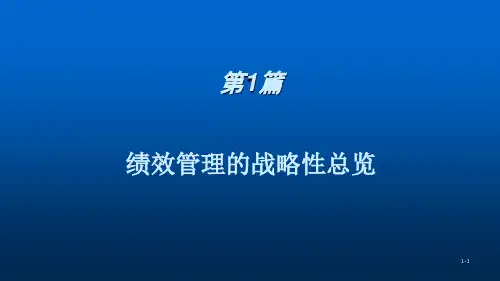
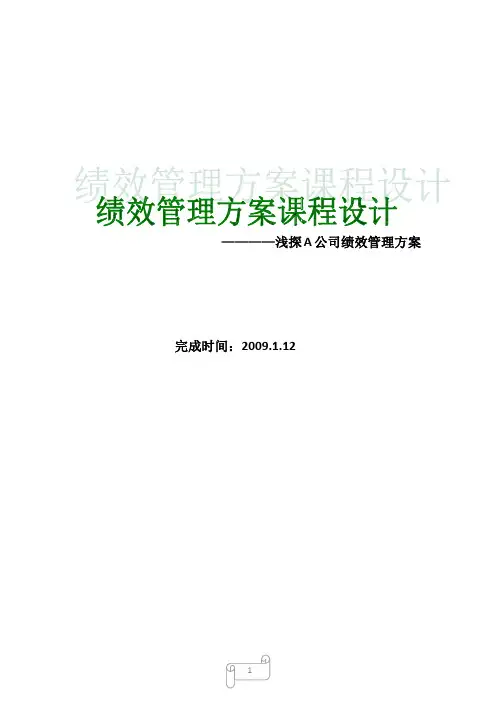
————浅探A公司绩效管理方案完成时间:2009.1.12信息管理学院目录Chapter1 A公司背景介绍。
03 Chapter2 A公司绩效管理体系介绍.。
031、绩效管理目的。
032、绩效管理体系设计原则。
043、绩效管理执行原则。
044、绩效分类与考核对象。
045、绩效考核对象、内容、频率。
056、绩效考核实施流程。
057、考核权限。
058、绩效评价。
069、考核结果的应用。
0610、考核申诉程序。
0711、注意考核中的误区。
08 Chapter3 绩效考核实施方案。
091、前提条件。
092、绩效计划。
093、绩效执行。
094、绩效考核与评价。
105、绩效反馈。
15 Chapter4 具体职位的绩效考核。
17一、A公司背景介绍A公司是一家处于成长期的冷饮连锁店,以生产美味优质的产品、提供优雅的环境和优质的服务,创造品牌优势,为顾客带来美味的享受和生活的快乐为自己的战略目标。
近年来,在差异化战略的指导下,公司规模得以迅速扩张,现已拥有3家连锁店。
为实现公司的战略目标,迅速扩大市场份额,获得消费者的支持,绩效管理必须被提升到战略的高度。
组织结构:二、A公司绩效管理体系介绍1、绩效管理目的通过对组织、个人的工作绩效的管理和评估,提高个人的工作能力和工作绩效,从而提高组织整体的工作效能,完善人力资源管理机制,最终实现企业愿景目标。
同时,通过规范化的关键绩效、工作目标设定、沟通、绩效审查与反馈工作,改进和提高管理人员的管理能力和成效,促进被考核者工作方法和绩效的提升,最终实现组织整体工作方法和工作绩效的提升。
最后,正式的综合考核结果作为物质激励(工资调整、奖金分配)和人员调整(人员晋升、降职调职)的依据或阶段的考核结果作为日常精神激励的评判标准。
2、绩效管理体系设计原则⏹强调考核体系的实效和可操作性,以易于执行为基本设计思路⏹不追求精细化,以启动考核实施为目的,在实际过程中逐步完善考核管理体系⏹不以奖惩为考核目的,强调对员工的绩效改进和提升3、绩效管理执行原则⏹公开性原则:让被考核者了解考核的程序、方法及考核结果等事宜,使考核有透明度。
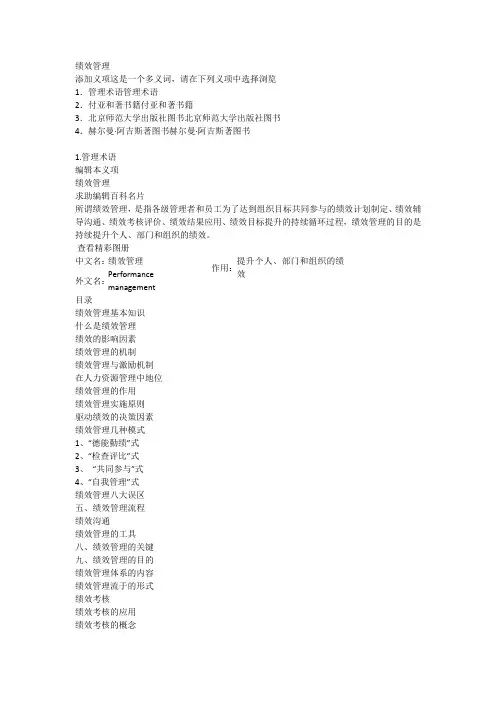
绩效管理添加义项这是一个多义词,请在下列义项中选择浏览1.管理术语管理术语2.付亚和著书籍付亚和著书籍3.北京师范大学出版社图书北京师范大学出版社图书4.赫尔曼·阿吉斯著图书赫尔曼·阿吉斯著图书1.管理术语编辑本义项绩效管理求助编辑百科名片所谓绩效管理,是指各级管理者和员工为了达到组织目标共同参与的绩效计划制定、绩效辅导沟通、绩效考核评价、绩效结果应用、绩效目标提升的持续循环过程,绩效管理的目的是持续提升个人、部门和组织的绩效。
查看精彩图册中文名: 绩效管理 外文名: Performance management作用: 提升个人、部门和组织的绩效 目录绩效管理基本知识什么是绩效管理绩效的影响因素绩效管理的机制绩效管理与激励机制在人力资源管理中地位绩效管理的作用绩效管理实施原则驱动绩效的决策因素绩效管理几种模式1、“德能勤绩”式2、“检查评比”式3、 “共同参与”式4、“自我管理”式绩效管理八大误区五、绩效管理流程绩效沟通绩效管理的工具八、绩效管理的关键九、绩效管理的目的绩效管理体系的内容绩效管理流于的形式绩效考核绩效考核的应用绩效考核的概念绩效考评的方式绩效考核的体系建立与监控中国绩效管理致命伤企业对绩效管理的误区绩效管理的四个理念绩效管理的系统的确立绩效管理的作用绩效管理注意事项展开绩效管理基本知识什么是绩效管理绩效的影响因素绩效管理的机制绩效管理与激励机制在人力资源管理中地位绩效管理的作用绩效管理实施原则驱动绩效的决策因素绩效管理几种模式1、“德能勤绩”式2、“检查评比”式3、“共同参与”式4、“自我管理”式绩效管理八大误区五、绩效管理流程绩效沟通绩效管理的工具八、绩效管理的关键九、绩效管理的目的绩效管理体系的内容绩效管理流于的形式绩效考核绩效考核的应用绩效考核的概念绩效考评的方式绩效考核的体系建立与监控中国绩效管理致命伤企业对绩效管理的误区绩效管理的四个理念绩效管理的系统的确立绩效管理的作用绩效管理注意事项展开编辑本段绩效管理基本知识什么是绩效管理《绩效管理方案设计与实施》[1]绩效管理循环绩效计划制定是绩效管理的基础环节,不能制定合理的绩效计划就谈不上绩效管理;绩效辅导沟通是绩效管理的重要环节,这个环节工作不到位,绩效管理将不能落到实处;绩效考核评价是绩效管理的核心环节,这个环节工作出现问题绩效管理会带来严重的负面影响;绩效结果应用是绩效管理取得成效的关键,如果对员工的激励与约束机制存在问题,绩效管理不可能取得成效。
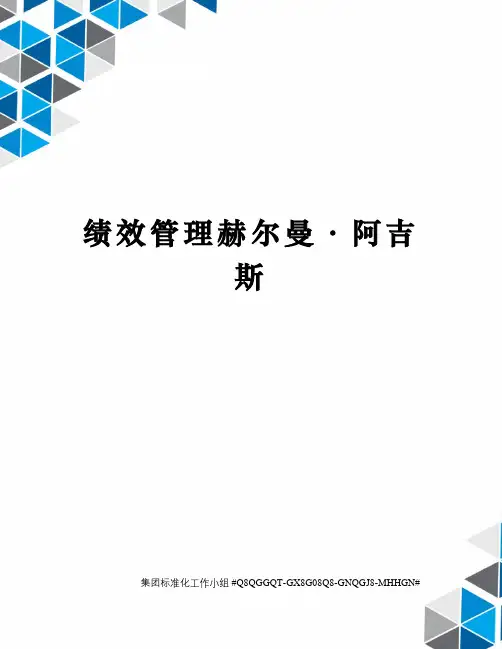
绩效管理赫尔曼·阿吉斯集团标准化工作小组 #Q8QGGQT-GX8G08Q8-GNQGJ8-MHHGN#绩效管理赫尔曼·阿吉斯第一章绩效管理与薪酬体系要点总结:➢绩效管理是指识别、衡量以及开发个人和团队绩效,并且使这些绩效与组织的战略目标保持一致的一个持续性过程。
➢尽管有许多组织都声称自己有所谓的“绩效管理”体系,但实际上,它们只不过是有一个绩效评价体系而已。
绩效评价所强调的是对员工的优点和缺点进行评价,它不涉及对战略方面问题的考虑。
此外,绩效评价通常也不包括对员工提供详尽而持续的绩效反馈,尽管员工可以利用这种反馈来改进他们的未来绩效。
最后,绩效评价常常是由人力资源管理部门推动的每年进行一次的活动,而绩效管理则是有管理者驱动并贯穿于全年的业务管理活动。
➢实施一套设计良好的绩效管理体系有许多优点。
从员工的角度来看,良好的绩效管理体系能够强化员工的工作积极性,增强其自尊心,帮助员工改善绩效,澄清工作任务和职责,为员工提供自我反省以及职业发展的机会,同时还能使员工更加清楚地了解上级对自己的期望。
而从管理者的角度来看,良好的绩效管理体系可以使他们更加清晰和深入了解下属的工作活动及其目标达成情况,使他们的管理活动变得更加公平和合理,使他们能够更清晰地向员工传达组织的目标并区分出优良绩效和不良绩效,同时,还可以推动组织的变革。
最后,从人人力资源管理职能的角度来看,一套好的绩效管理体系使组织在面临诉讼时能够有一种自我保护。
➢如果绩效管理体系设计不佳,执行不力,则有可能会给涉及的各方带来灾难性的后果。
比如,员工可能会离职,留下的员工也会缺乏动力;质量较低、执行较差的绩效管理体系还有可能给员工带来巨大的挫折感,同时使涉及的各方之间相互相互冷嘲热讽。
➢薪酬体系是雇佣关系的一个组成部分,它包括决定和分配有限报酬和无形报酬的所有机制。
有形报酬主要指薪酬,含货币性的薪酬、福利等;无形薪酬又称关系薪酬,其中包括领导的人口和在组织中的地位、就业保障、富有挑战性的工作以及学习机会等。
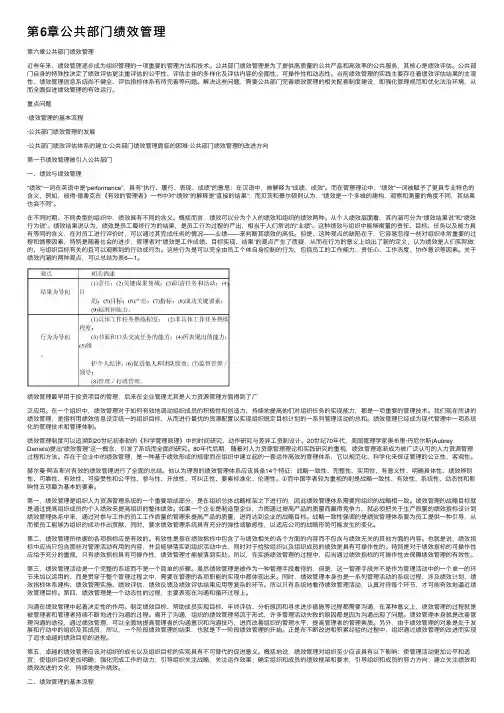
第6章公共部门绩效管理第六章公共部门绩效管理近些年来,绩效管理逐步成为组织管理的⼀项重要的管理⽅法和技术。
公共部门绩效管理是为了提供⾼质量的公共产品和⾼效率的公共服务,其核⼼是绩效评估。
公共部门⾃⾝的特殊性决定了绩效评估更注重评估的公平性、评估主体的多样化及评估内容的全⾯性、可操作性和动态性。
当前绩效管理的实践主要存在着绩效评估结果的主观性、绩效管理信息系统尚不健全、评估指标体系有待完善等问题。
解决这些问题,需要公共部门完善绩效管理的相关配套制度建设,即强化管理规范和优化法治环境,从⽽全⾯促进绩效管理的有效运⾏。
重点问题·绩效管理的基本流程·公共部门绩效管理的发展·公共部门绩效评估体系的建⽴·公共部门绩效管理⾯临的困难·公共部门绩效管理的改进⽅向第⼀节绩效管理被引⼊公共部门⼀、绩效与绩效管理“绩效”⼀词在英语中是“performance”,具有“执⾏、履⾏、表现、成绩”的意思;在汉语中,被解释为“成绩、成效”。
⽽在管理理论中,“绩效”⼀词被赋予了更具专业特⾊的含义,例如,彼得·德鲁克在《有效的管理者》⼀书中对“绩效”的解释是“直接的结果”;⽽贝茨和豪尔顿则认为,“绩效是⼀个多维的建构,观察和测量的⾓度不同,其结果也会不同”。
在不同时期、不同类型的组织中,绩效具有不同的含义。
概括⽽⾔,绩效可以分为个⼈的绩效和组织的绩效两种。
从个⼈绩效层⾯看,其内涵可分为“绩效结果说”和“绩效⾏为说”。
绩效结果说认为,绩效是员⼯最终⾏为的结果,是员⼯⾏为过程的产出,相当于⼈们常说的“业绩”。
这种绩效与组织中能够衡量的责任、⽬标、任务以及能⼒具有等同的含义,在对员⼯进⾏评价时,可以通过其完成任务的情况——业绩——来判断其绩效的⾼低。
但是,这种观点的缺陷在于,它容易忽视⼀些对组织⾮常重要的过程和情景因素,特别是随着社会的进步,管理者对“绩效是⼯作成绩、⽬标实现、结果”的观点产⽣了质疑,从⽽在⾏为的意义上给出了新的定义,认为绩效是⼈们实际做的、与组织⽬标有关的且可以观察到的⾏动或⾏为。
管理标准中心(Management Standards Center)关键管理胜任能力(能与自己的同事建立起建设性关系)(评判和监控他人的绩效能力)绩效管理体系能为组织带来以下贡献强化完成工作的动力增强员工的自尊心使管理者对下属有更深入的了解能够更加清晰的界定工作的内容以及需要达到的标准强化员工得自我认知和自我开发使管理活动更加公平和适宜是组织目标更加清晰使员工更加胜任使组织能更好的免于法律诉讼。
使组织能更快的区分绩效优良和绩效不佳的员工。
上级对员工得绩效看法能够更清晰的传递给员工。
使组织变革变得更加容易推动。
在实施绩效管理体系之前,应当对绩效管理可能引起的变化改革所带来的后果予以充分的考虑。
事实上,文化变革是由绩效的改变推动的。
一个组织的文化是不能被植入的。
它会受到组织实施和强化各种政策,实践、技能以及程序等的指导和影响。
改变企业文化的唯一方法就是改变员工每一天的工作方式。
绩效管理的目的:战略目的:帮助高层管理人员实现战略性经营目标,管理目的:为制定员工管理决策提供有效和有用的信息信息传递目的,告知员工他们的变现如何,并传达组织和管理者对他们的期望。
开发目的,是管理者对其下属提供指导组织维持目的,为人力资源规划和配置提供信息档案记录目的,收集可以用作各种目的的有用信息。
制定人力资源规划的一个重要内容是对企业内部的人才进行盘点,从而获取关于组织现有人力资源的信息。
理想的绩效管理体系具备的特征战略一致性完整性(四个维度:1、所有员工都应接受评价2、所有的主要工作职责都应当被评价(其中包括行为和结果)3、应当对整个绩效周期的内的绩效进行全面的评价。
4、对员工得绩效反馈不仅要提供积极的绩效信息,同时也要提供需要改进的负面绩效信息。
实用性有意义性(绩效管理体系应该为评估者提供次序不断的技能开发机会)明确具体性绩效辨别性可靠性有效性可接受性和公平性开放性可纠正性标准化伦理性进行职位分析的方法主要有:观察法、问卷调查法和访谈法观察法:让职位分析人员观察某一岗位上的任职者的工作活动,或者自己亲自去试一试这种工作,然后将结果整理成一份职位描述。
Chapter 2—Performance Management ProcessTrue/False Questions2.1Ability is the physical, emotional, intellectual, and psychological aptitude toperform the work.(Suggested points: 2, [2.1], pg.44)LO: 4 Answer:True2.2Knowledge is having the information to do the job and having experience at thejob.(Suggested points: 2, [2.1], pg.44)LO: 4 Answer:False. Knowledge includes only having the information needed to do the job but not necessarily having done the work.2.3Job descriptions stay stable over time and therefore do not need to be updated.(Suggested points: 2, [2.1], pg.51)LO: 4 Answer:False. Jobs change, so job descriptions must be checked and updated on ongoingbasis.2.4Results criteria fall into the following categories: quality, quantity, cost-effectiveness, and timeliness.(Suggested points: 2, [2.1], pg.51)LO: 5 Answer:True2.5Key accountabilities are the yardstick used to evaluate how well an employee hasachieved each objective.(Suggested points: 2, [2.2], pg.52)LO: 5 Answer:False. Performance standards are the yardstick used to evaluate how well anemployee has achieved each objective.2.6Employees should be measured exclusively on the results that they achieve.(Suggested points: 2, [2.2], pg.52)LO: 5 Answer:False. Employees should be measured on results and behaviors.2.7Employees and supervisors should both evaluate employee performance during theperformance assessment phase.(Suggested points: 2, [2.4], pg.56)LO: 7 Answer:True2.8Self-serving bias refers to the degree to which participants in job analysis differ inhow carefully they attend to the job analysis rating at hand.(Suggested points: 2, [2.1], pg.47)LO: 4 Answer:False. Carelessness bias refers to the degree to which participants in job analysisdiffer in how carefully they attend to the job analysis rating at hand.2.9It is very important that the components of a performance management system allbe related to one another.(Suggested points: 2, [2.1], pg.42)LO: 2 Answer:True2.10The employee should wait until the review cycle is over, or until a seriousproblem develops, to solicit performance feedback and ask for coaching.(Suggested points: 2, [2.3], pg.54)LO: 6 Answer:False. The employee should not wait until the review cycle is over to solicitperformance feedback in the form of “check-ins.” Also, the employee should notwait until a serious problem develops to ask for coaching.Multiple-Choice Questions2.11The two main steps in the prerequisites phase of performance management are:A. U nderstanding the organization’s mission and conducting job analysisB. D eveloping the organization’s mission and conducting job analysisC. Conducting job analysis and writing a development planD. U nderstanding the organization’s m ission and writing a development plan(Suggested points: 2, [2.1], pg.42)LO: 3 Answer: A2.12 A job description includes a summary of:A. Job dutiesB. Working conditionsC. Needed KSAsD. All of the above(Suggested points: 2, [2.1], pg.44)LO: 4 Answer: D2.13__________ are clusters of measurable KSAs.A. Job dutiesB. CompetenciesC. Performance standardsD. Key accountabilities(Suggested points: 2, [2.2], pg.52)LO: 5 Answer: B2.14Performance execution is linked to _____________ and _____________.A. prerequisites; performance planningB. performance planning; performance reviewC. performance planning; performance assessmentD. performance assessment; performance review(Suggested points: 2, [2.1], pg.42)LO:1 Answer: C2.15Self-ratings of performance are important because they do all of the followingEXCEPT:A. Emphasize discrepancies between the employee’s and supervisor’s views ofperformanceB. Reduce employee defensiveness during an appraisal meetingC. Decrease employee satisfaction with the performance management systemD. Increase employee ownership and commitment to the programs(Suggested points: 3, [2.4], pg.56)LO: 7 Answer: C2.16Performance reviews should focus on:A. What has been done and how (past)B. What compensation may be received as a consequence (present)C. Goals for the upcoming review period (future)D. All of the above(Suggested points: 2, [2.10, pg.57])LO: 8 Answer: D2.17The correct order of the phases of a performance management process is:A.Performance planning, prerequisites, performance execution, performanceassessment, performance review.B.Prerequisites, performance planning, performance execution, performanceassessment, performance review.C.Performance planning, prerequisites, performance execution, performancereview, performance assessment.D.Prerequisites, performance execution, performance planning, performanceassessment, performance review.(Suggested points: 2, [2.1], pg.42)LO: 1 Answer: B2.18The poor implementation of the performance planning phase will result in thepoor implementation of the:A.Performance execution phaseB.Performance assessment phaseC.Performance review phaseD.All of the above(Suggested points: 2, [2.4], pg.42)LO: 2 Answer: D2.19The prerequisites to the implementation of a performance management system are:A.Money and timeB.Knowledge of the organization’s culture and knowledge of the jobs inquestionC.Knowledge of the organization’s mission and knowledge of the organization’scultureD.Knowledge of the organi zation’s mission and knowledge of the jobs inquestion(Suggested points: 2, [2.6], pg. 43)LO: 3 Answer: D2.20Methods of conducting a work analysis include all of these EXCEPT:A.Reading textbooksB.Observation of employees in actionC.Off-the-shelf questionnairesD.Interviews with employees(Suggested points: 2, [2.2], pg.44)LO: 4 Answer: A2.21O*NET is:A.An online resource for pay scale informationB.An online resource for job testingC.An online resource for finding jobsD.An online resource for generic job descriptions(Suggested points: 2, [2.3], pg.48)LO: 4 Answer: D2.22During the performance planning component, the supervisor and employee meetto discuss and agree upon:A.The employee’s salaryB.Results, behaviors, and a development planC.Performance, corrections, and a timelineD.The supervisor’s expectations(Suggested points: 2, [2.2], pg.52]LO: 5 Answer: B2.23Which of the following are primarily the responsibilities of the employee in termsof performance execution?A.Check-ins and performance touchpointsB.Collection and sharing of performance datamitment to goal achievementD.All of the above(Suggested points: 2, [2.3], pg.55)LO: 6 Answer: D2.24Which of the following are primarily the responsibilities of the supervisor interms of performance execution?A.FeedbackB.Observation and documentationC.ReinforcementD.All of the aboveE. B and C only(Suggested points: 2, [2.3], pg.55)LO: 6 Answer: D2.25Which of the following statements is true according to the text?I. Employees are primarily responsible for finding resources for developmentplans in the performance execution state.II. Both employees and supervisors should rate performance in the performance assessment phase.III. Any discrepancy between employee and supervisor ratings is unacceptable.IV. Many sources can be utilized for data regarding performance.A.All of the statements are correct.B.I, II, and IV only are correct.C.II and IV only are correct.D.None of the statements are correct.(Suggested points: 2, [2.4], pg.56)LO: 7 Answer: C. Note: Supervisors, and NOT employees are primarily responsible forfinding resources for development plans in the performance execution state (pg. 55) 2.26The text offers six recommended steps for conducting productive performancereviews. Included in those steps are which of the following?A.Cite specific positive and negative behaviorsB.Agree on a bonusC.Agree on an action planD.A and C onlyE.None of the aboveF.All of the above(Suggested points: 2, [2.5], pg.58)LO:8 Answer: D2.27“KSA” in the text refers to what?A.Knowledge, social skills, and aptitudeB.Knowledge, skills, and abilitiesC.Knowledge, skills, and agilityD.Knowledge of situation and action(Suggested points: 2, [2.1], pg.44)LO: 3 Answer: B2.28Job descriptions are a key prerequisite for any performance management systembecause:A.Without them, employees will not “buy in” to the system.B.Performance management systems are not applicable unless certain jobelements are present.C.They provide the criteria that will be used in measuring performance.D.They provide information to employees as to what tasks are most important intheir jobs.(Suggested points: 2, [2.1], pg.51)LO: 4 Answer: C2.29In the performance planning stage, the term “results” refers to what?A.Customer reactionsB.Ratings that result from performanceC.Customer complaints resulting from performanceD.Outcomes an employee must produce(Suggested points: 2, [2.7], pg.52)LO: 5 Answer: D2.30During the collection of information from individuals for the purpose ofconducting a work analysis, why might different people in the same position andsame job duties rate certain knowledge, skills, and abilities (KSAs) as moreimportant than other KSAs?A.People tend to believe that the their own behaviors and personality traits aremore needed for successful job performance compared to behaviors andpersonality traits of others.B.Insufficient rater training was provided prior to the collection of informationfrom the individuals.C.Participants in job analysis differ in how carefully they attend to the jobanalysis rating at hand.D.All of the above(Suggested points: 2, [2.1], pg.47)LO: 4 Answer: D2.31 A Web-based training program, designed to reduce rater bias, does all of thefollowing EXCEPT:A.Provides a common point of referenceB.Allows raters to define each rating dimensionC.Defines the scale anchorsD.Describes what behaviors were indicative of each rating dimensionE.Permits raters to practice their rating skills(Suggested points: 2, [2.1], pg. 48)LO: 4 Answer: B. Note: Programs provide raters with definitions of rating dimensions,they do NOT allow raters to define rating dimensions.2.32People tend to attribute success to themselves and failure to external causes (i.e.,factors outside of their control). This tendency is called:A.Social projection biasB.Optimism biasC.Availability heuristicD.Self-serving biasE.False consensus bias(Suggested points: 2, [2.1], pg. 47)LO: 4 Answer: D2.33______________________ leads people to believe that others behave similarly tothemselves and hence lead people to think about themselves instead of people ingeneral when reporting KSAs for their jobs.A.Social projection biasB.Optimism biasC.Carelessness biasD.Self-serving biasE.False consensus bias(Suggested points: 2, [2.1], pg. 47)LO: 4 Answer: A2.34___________________leads people to believe that others share the same beliefsand attitudes as themselves.A.Social projection biasB.Optimism biasC.Carelessness biasD.Self-serving biasE.False consensus bias(Suggested points: 2, [2.1], pg. 47)LO: 4 Answer: E2.35___________________results from the use of automatic versus controlledprocessing of information, leading to differences in how carefully people attend to the job analysis rating task at hand.A.Social projection biasB.Optimism biasC.Carelessness biasD.Self-serving biasE.False consensus bias(Suggested points: 2, [2.1], pg.47)LO: 4 Answer: CShort-Answer and Essay-Type Questions2.35 Performance management is an ongoing process including five interrelatedcomponents. Please explain how the poor implementation of a phase in theprocess or how a disrupted link between any of the phases will have a negativeimpact on the performance management process as a whole.(Suggested points: 3, .5[Summary Point #2], .5[Summary Point #3], pg. 42, pg. 59)LO: 2 Answer:Each of the five components of the performance management process plays animportant role. If any of these components is implemented poorly, then the entire performance management system suffers. For example, the lack of knowledge ofthe organization’s mission and the job in question (i.e., prer equisites) will notallow performance planning (i.e., performance roadmap) to be aligned withorganizational goals, thereby leading to poor performance execution. In short, aperformance management system is only as good as its weakest component.The links between the various components need to be established clearly. Oneexample would be that performance planning needs to be closely related toperformance execution. Performance planning is a futile exercise if executiondoes not follow from planning. The same applies to all the various components of performance management.2.36 The employee and the supervisor both have important roles during theperformance execution phase. Please list and explain each party’s responsibilities in this phase of the performance management process.(Suggested points: 2, [2.3], ppg.54-55)LO: 6 Answer:During the performance execution phase, these are the employee’sresponsibilities:mitment to goal achievement. The employee must be committed to thegoals that were set. One way to enhance commitment is to allow the employeeto be an active participant in the process of setting the goals.B.Check-ins and performance touchpoints. The employee should not wait untilthe review cycle is over to solicit performance feedback. Also, the employeeshould not wait until a serious problem develops to ask for coaching. Theemployee needs to take a proactive role in soliciting performance feedbackand coaching from his or her supervisor.C.Collecting and sharing performance data. The employee should provide thesupervisor with regular updates on the employee’s progress toward goalachievement both in terms of behaviors and results.D.Preparing for performance reviews. The employee should not wait until theend of the review cycle approaches to prepare for the review. On the contrary,the employee should engage in an ongoing and realistic self-appraisal so thatcorrective actions can be taken if necessary. The usefulness of the self-appraisal process can be enhanced by gathering informal performanceinformation from peers and customers (both internal and external).During the performance execution phase, these are supervisor’s responsibilities:A.Observation and documentation. Supervisors must observe and documentperformance on a daily basis. It is important to keep track of examples of bothgood and poor performance.B.Updates. As the organization’s goals may change, it is important to update andrevise initial objectives, standards, and key accountabilities (in the case ofresults) and competency areas (in the case of behaviors).C.Feedback. Feedback on progression toward goals and coaching to improveperformance should be provided on a regular basis and certainly before thereview cycle is over.D.Resources. Supervisors should provide employees with resources andopportunities to participate in developmental activities. Thus, supervisorsshould encourage (and sponsor) participation in training, classes, and specialassignments.E.Reinforcement. Supervisors must let employees know that the employees’outstanding performance is noticed by reinforcing effective behaviors andprogress toward goals. Also, supervisors should provide feedback regardingnegative performance and how to remedy the observed problem. So,observation and communication are not sufficient. Performance problemsmust be diagnosed early on and appropriate steps taken as soon as the problemis discovered.2.37 Define knowledge in terms of the prerequisites needed for performance planning.(Suggested points: 2, [2.1], pg.44)LO: 3 Answer:Knowledge is having the information needed to perform the work but notnecessarily having done it.2.38 Define skills in terms of the prerequisites needed for performance planning.(Suggested points: 2, [2.1], pg.44)LO: 3 Answer:Skills are the required attributes that are usually acquired by having done thework in the past.2.39 Define abilities in terms of the prerequisites needed for performance planning.(Suggested points: 2, [2.2], pg.44)LO: 3 Answer:Abilities are the physical, emotional, intellectual, and psychological aptitude toperform the work, but neither having done it nor having been trained to do thework is required.2.40 In what ways is self-appraisal beneficial for performance assessment?(Suggested points: 2, [2.4], pg.56)LO: 7 Answer:With self-appraisal, there is a greater likelihood that the information will be usedproductively in the future. Self-appraisals can reduce employees’ resentfulnessand increase employee satisfaction with the performance management system.Also, the discrepancy between employee and supervisor appraisals is likely totrigger development efforts, particularly when supervisor appraisal is morenegative than employee self-appraisal.2.41Why is the performance review meeting considered the “Achilles’ heel of theentire process”?(Suggested points: 2, [2.5], pg.57)LO: 8 Answer:Many managers are uncomfortable with providing performance feedback,particularly when performance is deficient; this discomfort may lead to anxietyand the avoidance of the appraisal interview. Because each component of theperformance management process plays an important role, when any of thesecomponents is implemented poorly or not at all, then the entire performancemanagement system suffers.2.42 A good performance appraisal meeting includes discussions of what?(Suggested points: 2, [2.5], pg.57)LO: 8 Answer:A good performance appraisal meeting includes discussions of what has beendone and how (the past); goals and development plans the employee will beexpected to achieve during the following review period (the future); and what new compensation, if any, the employee may be receiving as a result of his/herperformance (the present).2.43 What are the five components in the performance management cycle?(Suggested points: 2, [2.1], pg.42)LO: 1 Answer:The five components of the performance management cycle are: prerequisites,performance planning, performance execution, performance assessment, andperformance review.2.44 List the six recommended steps for conducting productive performance reviews.(Suggested points: 2, [2.5], pg. 58)LO: 8 Answer:The six recommended steps for conducting productive performance reviews are:A.Identify what the employee has done well and poorly by citing specificbehaviors.B.Solicit feedback from the employee about these behaviors.C.Discuss the implications of changing or not changing the behaviors.D.Explain to the employee how skills used in past achievements can helpovercome any current performance problems.E.Agree on an action plan.F.Set a meeting to follow up and agree on the behaviors, actions, and attitudesthat will be evaluated.2.45 Define self-serving bias, and explain how it may affect the job analysis process.(Suggested points: 3, [2.1], pg.47)LO: 4 Answer:Self-serving bias is the tendency for people to attribute success to themselves and failure to external causes (i.e., factors outside of their control). As a result, thisbias leads people to report that their own behaviors and personality traits are more needed for successful job performance compared to behaviors and personalitytraits of others.2.46 Distinguish between social projection bias and false consensus bias.(Suggested points: 3, [2.1], pg.47)LO: 4 Answer:Social projection bias leads people to believe that others behave similarly tothemselves and hence leads people to think about themselves instead of people in general when reporting KSAs for their jobs. False consensus bias is different from social projection bias, because false consensus bias leads people to believe thatothers share the same beliefs and attitudes as themselves.2.47How do the self-serving, social projection, false consensus biases, andcarelessness bias commonly affect the job analysis process?(Suggested points: 3, [2.1], pg.48)LO: 4 Answer:Self-serving, social projection, and false consensus biases, and carelessness biasaffect job analysis ratings because they lead people to believe that their ownKSAs are those driving success in their jobs. So, these lead to an exaggeratedview regarding the KSAs needed—and this exaggeration is based on precisely the KSAs that job incumbents have.2.48How does a Web-based rater training program work to help raters become lesssusceptible to rater biases and thus more accurate in the ratings that are collectedin a job analysis?(Suggested points: 3, [2.1], pg. 48)LO: 4 Answer:Taken together, self-serving, social projection, false consensus biases, andcarelessness bias affect job analysis ratings because they lead people to believethat their own KSAs are those driving success in their jobs. So, these lead to anexaggerated view regarding the KSAs needed—and this exaggeration is based on precisely the KSAs that job incumbents have. Given such, a rater trainingprogram helps participants converge onto a common point of reference, which is a point where the exaggeration is significantly mitigated. As a result, rater trainingprogram participants tend to provide significantly lower ratings for certain KSAsthan do nonparticipants who tend to exaggerate those KSAs.2.49 List the five steps that typically make up a Web-based rater training program.(Suggested points: 3, [2.1], pg. 48)LO: 4 Answer:A Web-based training program usually includes the following five steps:(1) Provide raters with a definition of each rating dimension.(2) Define the scale anchors.(3) Describe what behaviors were indicative of each dimension.(4) Allow raters to practice their rating skills.(5) Provide feedback on the practice。
第一章绩效管理与薪酬体系一、绩效管理的定义1、绩效管理的概念绩效管理是指识别、衡量以及开发个人和团队绩效,并且使这些绩效与组织的战略目标保持一致的持续性过程。
这一定义包含两方面重要含义:⏹持续性过程:绩效管理是持续性的。
它包括从设定目标和任务,观察绩效,再到提供、接受指导和反馈这样一个永不停止的过程。
⏹与战略目标保持一致:绩效管理要求管理者确保员工的工作活动和产出与组织的目标是一致的,并借此帮助组织赢得竞争优势。
因此,绩效管理在员工的绩效和组织的目标之间就建立起了一个直接的联系,从而使员工对组织作出的贡献变得清晰。
2、绩效管理与绩效评价的区别如果一个组织只是每年对员工的绩效进行一次评价,而并没有通过对员工提供持续性的反馈和辅导来帮助他们改进绩效,在这个组织中就没有真正的绩效管理体系,只不过是一个绩效评价体系而已。
绩效评价是对一位员工的优点和不足所进行的系统性描述。
因此,绩效评价是绩效管理的一个重要组成部分,它只是一个大的整体中的一小部分而已。
二、绩效管理对组织的贡献1、强化完成工作的动力;2、增强员工的自尊心;3、使管理者对下属有更深入的了解;4、能够更加清晰地界定工作的内容及其需要达到的标准;5、强化员工的自我认知和自我开发;6、使管理活动更加公平和适宜;7、使组织目标更加清晰;8、使员工更加胜任;9、使组织能更好地免受法律诉讼;10、使组织能更快、更及时地区分绩效优良与绩效不佳的员工;11、上级对员工绩效的看法能够更清晰地传递给员工;12、使组织变革更加容易推动。
三、糟糕的绩效管理体系给组织带来的不利或危害1、增加人员流动率;2、使用错误的或者带有误导性的信息;3、损伤员工的自尊心;4、浪费时间和金钱;5、损害人际关系;6、削弱完成工作任务的动力;7、员工产生工作倦怠感,工作满意度下降;8、增加遭遇诉讼的风险;9、对管理层资源产生不合理的需求;10、绩效评价标准和评价结果不稳定、不公平;11、产生偏见;12、绩效评价等级体系不清晰。
第一章绩效管理与薪酬体系
一、绩效管理的定义
1、绩效管理的概念
绩效管理是指识别、衡量以及开发个人和团队绩效,并且使这些绩效与组织的战略目标保持一致的持续性过程。
这一定义包含两方面重要含义:
⏹持续性过程:绩效管理是持续性的。
它包括从设定目标和任务,观察绩效,再到提供、
接受指导和反馈这样一个永不停止的过程。
⏹与战略目标保持一致:绩效管理要求管理者确保员工的工作活动和产出与组织的目标
是一致的,并借此帮助组织赢得竞争优势。
因此,绩效管理在员工的绩效和组织的目标之间就建立起了一个直接的联系,从而使员工对组织作出的贡献变得清晰。
2、绩效管理与绩效评价的区别
如果一个组织只是每年对员工的绩效进行一次评价,而并没有通过对员工提供持续性的反馈和辅导来帮助他们改进绩效,在这个组织中就没有真正的绩效管理体系,只不过是一个绩效评价体系而已。
绩效评价是对一位员工的优点和不足所进行的系统性描述。
因此,绩效评价是绩效管理的一个重要组成部分,它只是一个大的整体中的一小部分而已。
二、绩效管理对组织的贡献
1、强化完成工作的动力;
2、增强员工的自尊心;
3、使管理者对下属有更深入的了解;
4、能够更加清晰地界定工作的内容及其需要达到的标准;
5、强化员工的自我认知和自我开发;
6、使管理活动更加公平和适宜;
7、使组织目标更加清晰;
8、使员工更加胜任;
9、使组织能更好地免受法律诉讼;
10、使组织能更快、更及时地区分绩效优良与绩效不佳的员工;
11、上级对员工绩效的看法能够更清晰地传递给员工;
12、使组织变革更加容易推动。
三、糟糕的绩效管理体系给组织带来的不利或危害
1、增加人员流动率;
2、使用错误的或者带有误导性的信息;
3、损伤员工的自尊心;
4、浪费时间和金钱;
5、损害人际关系;
6、削弱完成工作任务的动力;
7、员工产生工作倦怠感,工作满意度下降;
8、增加遭遇诉讼的风险;
9、对管理层资源产生不合理的需求;
10、绩效评价标准和评价结果不稳定、不公平;
11、产生偏见;
12、绩效评价等级体系不清晰。
四、薪酬体系的定义
薪酬体系指用来分配各种有形报酬和无形保持的一套机制,它是雇佣关系的一个组成部分。
1、基本薪资
基本薪资是企业向员工支付的用来与他们所完成的工作进行交换的一种报酬形式。
基本薪资通常包括一个变动范围,它的支付依据主要是岗位以及岗位所履行的职责,而不是个人所做的贡献。
因此,一般情况下,履行类似工作职责的所有员工所得到的基本薪资都是一样的,并不考虑员工与员工之间的个人差异。
不过,基本薪资通常会有一个变动范围,从事类似工作的员工所得到基本薪资可以在这个范围内有所不同,这种差异主要取决于员工个人在工作经验以及绩效等方面的差异。
2、生活成本调薪和绩效加薪
生活成本调薪意味着所有员工都可以得到一个相同百分比的薪资水平上涨,这种调薪不考虑员工个人的绩效,生活成本调薪的目的主要是用来消除通货膨胀对员工的收入造成的不利影响,以保证员工薪资水平的购买力。
浮动薪资,有时又称绩效加薪,是指根据员工过去的绩效表现给予的基本薪资增长待遇。
3、短期奖励
与绩效加薪类似,短期奖励也是以员工过去的绩效为基础的。
不过,这种奖励不会导致基本薪资的增加,它只是根据某个绩效周期(如季度或年度)内的评价结果来计发的临时性薪资调整。
因此,短期奖励是一种一次性的支付,正因为如此,它也常常被称为可变薪酬。
短期奖励与绩效加薪的第二个不同之处在于,短期奖励的标准是事先确定的。
相反,在绩效加薪时,在大多数情况下,加薪的具体数值是事先不知道的。
4、长期奖励
短期奖励通常试图在短期(如季度或年度)通过现金奖励或者特别奖赏(如给予两天的额外带薪假期)的办法来激励员工的绩效,而长期奖励则力图在一个相对较长的时间里影响员工的未来绩效。
典型的长期奖励计划包括允许员工按照预先确定好的、有利可图的价格来购买股票所有权计划或者股票期权计划。
长期奖励的基本原理是,员工个人愿意对组织的未来成功进行投资,而这种投资又有可能转化为一种可持续的高水平绩效。
短期奖励和长期奖励的应用都非常普遍。
5、收入保障
收入保障计划是在一位员工生病、残疾或者丧失工作能力时,组织为其提供的一种薪资补充和支持计划。
有些国家还通过法律强制组织制定收入保障计划。
在收入保障计划之下包括像医疗保险、养老金计划以及储蓄计划等类型的福利计划。
6、生活和工作平衡
与工作和生活的平衡有关的福利计划主要是用来帮助员工在工作活动与非工作活动之间达成更好的平衡。
7、补贴
在有些国家和组织的福利中,还包括像住房补贴和交通补贴等项目。
8、关系报酬
关系报酬在本质上是无形的,它包括上级的认可和在组织中的地位、就业保障、富有挑战性的工作、学习的机会以及在工作中构建私人关系的机会(其中包括友谊和爱情)。
五、绩效管理体系的目的和作用
1、战略目的:帮助高层管理人员实现战略性经营目标;
2、管理目的:为制定员工管理决策提供有效和有用的信息;
3、信息传递目的:告知员工他们的表现如何,并传达组织和管理者对他们的期望;
4、开发目的:使管理人员对他们的下属提供指导;
5、维持组织目的:为人力资源规划和配置提供信息;
6、档案记录目的:收集可以用作各种目的的有用信息(如甄选测试开发工具、管理决策等)。
【①完善管理职能,监控计划、组织、领导和控制四项职能的执行状况;②促成量化管理,使得公司的各层次决策更多的依赖于数据分析或询证;③促成组织内部沟通、监控机制的形成;
④避免不必要的资源浪费。
】
六、理想的绩效管理体系具备的特征
1、战略一致性
⏹个人目标、部门目标和组织目标相一致。
2、完整性
⏹所有的员工都要接受评价;
⏹绩效评价涵盖整个绩效审查周期;
⏹所有的主要工作职责都要接受评价;
⏹无论优良绩效还是不良绩效,都应当提供反馈。
3、实用性
⏹可用性强;
⏹容易使用;
⏹利用其进行决策的人接受这套体系;
⏹这套体系的收益大于成本。
4、有意义性
⏹每一种工作职责的绩效标准和评价内容都是重要的而且是相关的;
⏹只对员工具有控制能力的工作职责进行衡量和评价;
⏹绩效评价定期举行并且时机恰当;
⏹这套体系能够为评价者提供持续性的技能开发;
⏹绩效评价结果被用于重要的管理决策。
5、明确具体性
⏹这套体系能够给员工提供详细的指导,让他们指导组织对他们的期望是什么,同时他
们在多大程度上达到了组织的这些期望。
6、绩效辨别性
⏹这套体系应当能够识别出有效和无效的行为和结果,因此也能够识别出具有各种不同
绩效水平的员工。
7、可靠性
⏹绩效衡量指标是一致的;
⏹绩效衡量指标是没有偏差的。
8、有效性
⏹在绩效衡量指标中包含了所有的关键绩效内容;
⏹绩效衡量指标没有遗漏任何重要的绩效内容;
⏹绩效衡量指标中不能包含员工不可控的因素。
9、可接受性和公平性
⏹员工认为绩效评价结果以及根据绩效评价结果所确定的报酬是公平的(分配公平);
⏹员工认为决定绩效评价等级以及后来的报酬的程序是公平的(程序公平)。
10、参与性
⏹在举行绩效评价会议之前,首先从员工那里收集他们的个人绩效信息;
⏹员工通常对如何衡量自己的绩效提供建议,以参与到绩效管理体系的创建过程中。
11、开放性
⏹经常对绩效进行评价,同时持续性地提供绩效反馈;
⏹绩效评价会议是一个双向沟通过程,而不是一个管理者直接将信息传递给员工的单向
过程;
⏹绩效标准是清晰的,并且持续性地提供给员工;
⏹绩效沟通是以事实为依据的、公开的、坦诚的。
12、可纠正性
⏹绩效体系中应当有一个申诉程序,以使员工可以通过这个程序对不公平或不正确的决
定提出质疑。
13、标准化
⏹绩效评价对于不同的人以及在不同的时间里具有一致性。
14、伦理化
⏹管理者在进行绩效评价时必须抛开其个人的好恶;
⏹员工的隐私应当得到尊重。
七、绩效管理与其他人力资源管理和开发活动的整合
绩效管理体系是其他人力资源管理和开发活动的一个重要支持者:
1、绩效管理为确定员工的开发需求提供信息;
2、绩效管理为人力资源规划提供了关键性的信息;
3、绩效管理为薪酬管理提供信息。
第二章绩效管理的过程
第三章绩效管理与战略规划。